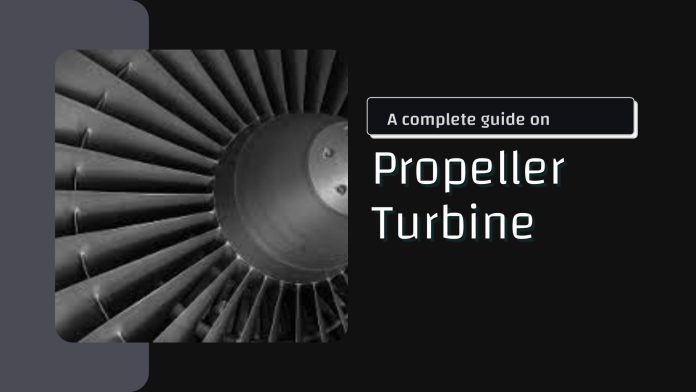In ships and submarines, a propeller turbine is a form of inward flow reaction turbine with a propeller-shaped runner. It can be ordered with fixed or adjustable blades. The water flow in the propeller turbine is controlled by movable guiding vanes (or wicket gates). The vanes direct the water into the runner, where it is transferred to the blades. In hydraulic settings with large flow rates, the propeller turbine is commonly used.
Bulb turbine, Straflo turbine, tube turbine, and Kaplan turbine are examples of propeller turbines used in the hydraulic power industry.
Working Principle of a Propeller Turbine
Propeller-type reaction turbines are the most common. The runner of a propeller turbine usually has three to six blades, which are constantly struck by water. The pitch of the blade might be fixed or changeable. The runner, scroll case, wicket gates, and draft tube are the major components of a propeller turbine.
The propeller, which includes the rotating hub and blades, is the most important part of the runner because it transports fluid potential and kinetic energy to the turbine shaft. Propellers are categorized using a variety of criteria, including the number of blades and blade pitch. To understand more about the propeller, go to this page. Most propeller turbines have axial flow, which is parallel to the rotating axis. As a result, they are classified as mid-flow turbines.
Propeller turbine units with vertical shafts were employed in early prototypes. A horizontal shaft is used in more recent innovations. Fured-blade runners are firmly attached blades that are rigidly attached to the hub of a propeller turbine. The runner blades can also be made changeable, allowing the turbine to perform better in a variety of flow circumstances.
A Kaplan turbine is a propeller turbine with movable blades and gates named after its designer, Viktor Kaplan. A semi-Kaplan turbine is a propeller-type turbine with movable blades and fixed gates. The hydraulic performance of such units is improved by the automatic synchronization of runner blade movement and the adjustment of wicket gate position, making them more efficient for variable flow rates and low head applications.
Propeller turbines are designed for heads ranging from 1.5 to 60 meters, but they are most commonly utilized for heads under 30 meters. The flow range of a fixed blade propeller turbine should be between 75 and 100 percent of the best efficiency point (BEP) flow. The best efficiency discharge rate for Kaplan turbines is between 25 and 125 percent. The head range required for adequate turbine performance is 20 to 140 percent of the design head.
The turbine control system enhances the security of the turbines. The monitor and analyze the turbine working. IS200TPROH1B, IS200TREGH1B are some examples of gas turbine control system parts.
Types of Propeller Turbines
Although the Kaplan turbine is the most well-known type of propeller turbine, there are several types of Propeller Turbines.
Bulb Turbine
The turbine and generator are sealed and inserted directly in the water flow in the bulb turbine. Bulb turbines are best for low heads under 25 meters. The water flow is practically straight, which minimizes both size and cost. A bulb turbine is a small turbine with an upstream waterproof shell and a horizontally positioned generator. Due to the sealed turbine and generator, these turbines have the advantage of taking up less space. This trait, however, makes it difficult to service turbine components.
Bulb turbines can also work in the opposite direction of the flow. An additional set of gears is used to boost the generator’s rotating speed for very low heads. However, instead of a bulb, both the setup gears and the generator are placed in an open pit. Bulb turbines can produce electricity in the range of 10 to 100 megawatts.
Straflo Turbine
L. F. Harza, an American, invented rim-generator turbines. During World War II, European businesses manufactured the first units. Escher Wyss, the company that develops these rim-generator units, has chosen the term “Straflo” as the exclusive name. Straight flow is abbreviated as Straflo, a recognized trademark.
Tube turbine
In a tube turbine, the penstock curves just before or after the runner, which connects to the generator in a straight line. The tube turbines produce between 20 and 700 kW of output power. Tube turbines are direct drives, meaning the turbine and generator are positioned on the same shaft with the same bearings and seals.
Kaplan Turbine
The blades and wicket gates of a Kaplan turbine are both changeable, making it a versatile turbine with a wide range of applications. The rotor is attached to the turbine shaft and spins at a fixed rotational speed in this form of propeller turbine. The electromagnetic field poles flow through the conductors in the stator when the rotor rotates. This generates an electric current and causes the voltage to develop at the generator’s output terminals.
Advantages and Disadvantages of Propeller Turbines
Different types of propeller turbines have been designed for diverse purposes, as previously stated. They do, however, share some common qualities and flaws, some of which are detailed below.
Advantages
- Impeller turbines are typically employed for applications in small heads when other alternatives, like Francis, are not practical.
- The hydraulic efficiency of impeller turbines with adjustable blades or guiding veins can be optimized to meet flow conditions.
- One of the benefits of groups of impeller turbines, such as bulb turbines, is their compactness.
- They necessitate less expensive and more compact construction.
Disadvantages
- It can be difficult to reach various components for maintenance if the generator and rotor are sealed in samples like bubbles and Straflo.
- Some of the problems that propeller turbines face include cavitation and its effects.
- Water leaking into the generator housing has the potential to damage the hydroelectric system.
- Propeller turbines are often powered by a high amount of water flow.










